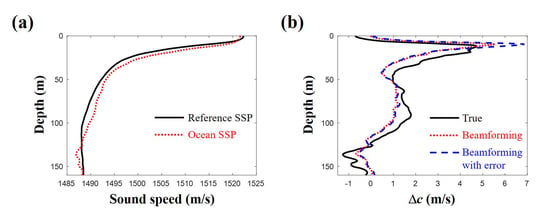Compressive Sound Speed Profile Inversion Using Beamforming Results
Abstract
:1. Introduction
2. Compressive SSP Inversion
2.1. Formulation of the Compressive SSP Inversion
2.2. Objective Function in the Compressive SSP Inversion
3. Numerical Experiments: SWellEx-96
3.1. SSP Dictionary: Gaussian Shape Functions
3.2. SSP Dictionary: EOFs
3.3. Examination of the Compressive SSP Estimation
3.4. Application: SSP in SWellEx-96
4. Conclusions
Author Contributions
Funding
Conflicts of Interest
References
- Collins, M.D.; Kuperman, W.A. Focalization: Environmental focusing and source localization. J. Acoust. Soc. Am. 1991, 90, 1410–1422. [Google Scholar] [CrossRef] [PubMed]
- Huang, C.F.; Gerstoft, P.; Hodgkiss, W.S. Effect of ocean sound speed uncertainty on matched-field geoacoustic inversion. J. Acoust. Soc. Am. 2008, 123, EL162–EL168. [Google Scholar] [CrossRef] [PubMed]
- Park, C.; Seong, W.; Gerstoft, P.; Hodgkiss, W.S. Geoacoustic inversion using backpropagation. IEEE J. Ocean. Eng. 2010, 35, 722–731. [Google Scholar] [CrossRef]
- Tan, B.A.; Gerstoft, P.; Yardim, C.; Hodgkiss, W.S. Broadband synthetic aperture geoacoustic inversion. J. Acoust. Soc. Am. 2013, 134, 312–322. [Google Scholar] [CrossRef] [PubMed]
- Tolstoy, A. Sensitivity of matched field processing to sound-speed profile mismatch for vertical arrays in a deep water Pacific environment. J. Acoust. Soc. Am. 1989, 85, 2394–2404. [Google Scholar] [CrossRef]
- Munk, W.; Wunsch, C. Ocean acoustic tomography: A scheme for large scale monitoring. Deep-Sea Res. 1979, 26A, 123–161. [Google Scholar] [CrossRef]
- Shang, E.C. Ocean acoustic tomography based on adiabatic mode theory. J. Acoust. Soc. Am. 1989, 85, 1531–1537. [Google Scholar] [CrossRef]
- Tolstoy, A.; Diachok, O.; Frazer, L.N. Acoustic tomography via matched field processing. J. Acoust. Soc. Am. 1991, 89, 1119–1127. [Google Scholar] [CrossRef]
- Tolstoy, A. Linearization of the matched field processing approach to acoustic tomography. J. Acoust. Soc. Am. 1992, 91, 781–787. [Google Scholar] [CrossRef]
- Bianco, M.; Gerstoft, P. Compressive acoustic sound speed profile estimation. J. Acoust. Soc. Am. 2016, 139, EL90–EL94. [Google Scholar] [CrossRef] [PubMed]
- Jensen, F.B.; Kuperman, W.A.; Porter, M.B.; Schmidt, H. Wave Propagation Theory, Ray Method, and Signals in Noise. In Computational Ocean Acoustics; Springer: New York, NY, USA, 2011; pp. 32–58. [Google Scholar]
- Donoho, D.L. Compressed sensing. IEEE Trans. Inf. Theory 2006, 52, 1289–1306. [Google Scholar] [CrossRef]
- Candes, E.J.; Wakin, M.B. An introduction to compressive sampling. IEEE Sign. Process. Mag. 2008, 25, 21–30. [Google Scholar] [CrossRef]
- Edelmann, G.F.; Gaumond, C.F. Beamforming using compressive sensing. J. Acoust. Soc. Am. 2011, 130, EL232–EL237. [Google Scholar] [CrossRef] [PubMed]
- Gerstoft, P.; Xenaki, A.; Mecklenbrauker, C.F. Multiple and single snapshot compressive beamforming. J. Acoust. Soc. Am. 2015, 138, 2003–2014. [Google Scholar] [CrossRef] [PubMed]
- Malioutov, D.; Cetin, M.; Willsky, A.S. A sparse signal reconstruction perspective for source localization with sensor arrays. IEEE Trans. Signal Process. 2005, 53, 3010–3022. [Google Scholar] [CrossRef]
- Xenaki, A.; Gerstoft, P.; Mosegaard, K. Compressive beamforming. J. Acoust. Soc. Am. 2014, 136, 260–271. [Google Scholar] [CrossRef] [PubMed]
- Xenaki, A.; Gerstoft, P. Grid-free compressive beamforming. J. Acoust. Soc. Am. 2015, 137, 1923–1935. [Google Scholar] [CrossRef] [PubMed] [Green Version]
- Choo, Y.; Seong, W. Compressive spherical beamforming for localization of incipient tip vortex cavitation. J. Acoust. Soc. Am. 2016, 140, 4085–4090. [Google Scholar] [CrossRef] [PubMed]
- Gemba, K.L.; Hodgkiss, W.S.; Gerstoft, P. Adaptive and compressive matched field processing. J. Acoust. Soc. Am. 2017, 141, 92–103. [Google Scholar] [CrossRef] [PubMed]
- Park, Y.; Seong, W.; Choo, Y. Compressive time delay estimation off the grid. J. Acoust. Soc. Am. 2017, 141, EL585–EL591. [Google Scholar] [CrossRef] [PubMed]
- Yardim, C.; Gerstoft, P.; Hodgkiss, W.S.; Traer, J. Compressive geoacoustic inversion using ambient noise. J. Acoust. Soc. Am. 2014, 135, 1245–1255. [Google Scholar] [CrossRef] [PubMed]
- Bianco, M.; Gerstoft, P. Dictionary learning of sound speed profiles. J. Acoust. Soc. Am. 2017, 141, 1749–1758. [Google Scholar] [CrossRef] [PubMed]
- Grant, M.; Boyd, S. CVX: Matlab Software for Disciplined Convex Programming, version 2.1. Available online: http://cvxr.com/cvx (accessed on 3 April 2018).
- Tipping, M.E. Sparse Bayesian learning and the relevance vector machine. J. Mach. Learn. Res. 2001, 1, 211–244. [Google Scholar] [CrossRef]
















© 2018 by the authors. Licensee MDPI, Basel, Switzerland. This article is an open access article distributed under the terms and conditions of the Creative Commons Attribution (CC BY) license (http://creativecommons.org/licenses/by/4.0/).
Share and Cite
Choo, Y.; Seong, W. Compressive Sound Speed Profile Inversion Using Beamforming Results. Remote Sens. 2018, 10, 704. https://doi.org/10.3390/rs10050704
Choo Y, Seong W. Compressive Sound Speed Profile Inversion Using Beamforming Results. Remote Sensing. 2018; 10(5):704. https://doi.org/10.3390/rs10050704
Chicago/Turabian StyleChoo, Youngmin, and Woojae Seong. 2018. "Compressive Sound Speed Profile Inversion Using Beamforming Results" Remote Sensing 10, no. 5: 704. https://doi.org/10.3390/rs10050704
APA StyleChoo, Y., & Seong, W. (2018). Compressive Sound Speed Profile Inversion Using Beamforming Results. Remote Sensing, 10(5), 704. https://doi.org/10.3390/rs10050704






